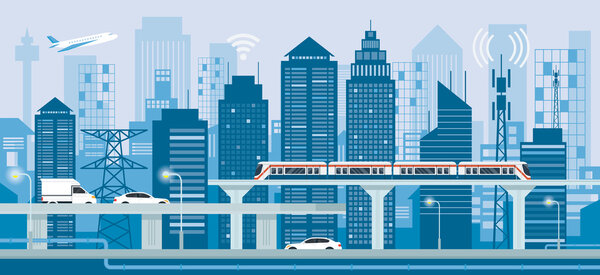
Keeping on the Smart Cities theme in a previous blog post, the steady rise of the Earth’s populations is migrating mostly to urban areas, where in the United States, mid-size cities are expected to experience the largest increase. This will undoubtedly put a huge strain on already exploding transportation infrastructures. The solution seen for Smart Cities development lies in building more efficient mobility. This will bring about a large paradigm shift for urban planners, transit agencies and operators who will have to rethink transport modes to offer a broader range of choices.
New options such as Mobility as a Service (MaaS) and autonomous trains have been identified as promising and the next steps in Smart Cities evolution. Autonomous train technology is currently being developed, and is different from driverless trains, which are already in use worldwide. MaaS, on the other hand, uses a digital network of devices that allows travellers to order end-to-end transport services across the entire spectrum of transit modes, instead of having to book each mode separately. This ingenious solution uses data based on real-time conditions and all available transport options to determine the most efficient means to get people to their destination, taking into account each passenger’s preferences.
Maximizing Mobility Resources
At the forefront of this movement, Kontron is actively developing next-generation computing and communications technologies to help urban planners realize ways of maximizing mobility resources while also reducing operator infrastructure needs. With years of experience and thousands of transportation system deployments under its belt, Kontron has the expertise to influence the digital transformation in transportation. This transformation is the required foundation to securely connect disparate systems and make them more intelligent resulting in high efficiency transportation system installations. This step is essential. As noted in the 2016 U.S. Department of Transportation (U.S. DOT) Smart Cities Challenge findings (Smart City Challenge Lessons Learned), only 28 percent of the transit agencies in the United States have open data systems that allow them to share transit schedules to the public.
Interoperability is the Key
Proven technology building blocks in this area are open architecture computing platforms. These workhorses of embedded computing provide highly-integrated, standards-based modular solutions that ensure interoperability between the diverse range of sub-systems used by transit agencies today. Along with interoperability, COTS-based transportation computers also simplify development so new systems that meet Smart City power, security and connectivity requirements can be installed quicker with a higher level of reliability.
Key technology enablers for autonomous vehicle development are the Internet of Things (IoT) and High Performance Embedded Computing (HPEC). IoT-enabled onboard gateways built from intelligent computing platforms provide the broad connectivity, system health management, built-in interoperability with enhanced security that makes effective and cost-efficient transit management possible.
Solutions for Autonomous Train Systems
Today’s powerful HPEC platforms offer built-in redundancy and deliver the performance necessary for autonomous operation, so transit agencies can reduce costly trackside infrastructure requirements. With HPEC platforms, transportation system developers get the support they need for SDN (Software Defined Networks) and NVF (Network Function Virtualization) technologies that, when combined with IoT-enabled gateways and Fog/Cloud processing, make up the foundation for MaaS and other efficient mobility models.
Kontron’s current generation of HPEC solutions offer rugged parallel server performance for autonomous train operations. Utilizing the highly-advanced processing capabilities of the 8-core Intel® Xeon® D-1540 (Broadwell DE), these platforms allow developers of autonomous train systems to leverage substantial efficiencies from isolating workloads that are configured to dynamically share common resources.
Helping urban planners, transit agencies and operators unlock the potential of efficient mobility options to support growing population centers, Kontron continues to work with developers of transportation systems to make sure they have the powerful technologies needed to make the Smart Cities evolution possible.
What further technical enablers do you see as integral in the Smart City evolution?
Read also more about the topic in our blog post “Embedded computing as a key issue for future traffic concepts”.
Cover picture: fotolia - muchmania

{{comment.comment}}